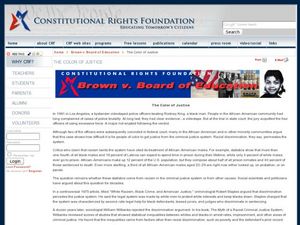Curated OER
Race and Voting in the Segregated South
Pupils examine the history of African American voting rights. In this voting rights lesson, students listen to a lecture on African American voting rights between the years 1890 and 1965. Pupils respond to discussion questions...
Curated OER
Three Visions for African Americans
Students consider the plight of African Americans in post-Reconstruction America. In this African American history activity, students discover the visions of African American leaders Booker T. Washington, W. E. B. Du Bois,...
Curated OER
Race and Representation
Students consider race and representation. In this voting rights lesson, students listen to their instructor lecture on the Voting Rights Act of 1965, Georgia congressional districts, and North Carolina voting districts. Students respond...
Curated OER
The Color of Justice
Learners analyze racism and justice. In this legal system discrimination lesson, students listen to their instructor lecture on disparities in the legal system. Learners respond to discussion questions following the...
Curated OER
Implementing a Civic Action Project
Young scholars follow a six step plan to create a civic action project. In this civics instructional activity, students create their own project based on interest and implement it to improve the school or local community. Goal setting...
Curated OER
Korea's Literary Tradition
Students read a text about Korea's literary tradition. In this literary tradition lesson, students read the multiple page text to learn about Korea's literary tradition.
Curated OER
Etymology
Learners dissect and build words from parts like prefixes, base words, suffixes, and inflectional endings. Etymology skills help us find the meanings of words by identifying the different parts that constitute them. Class members use...
Curated OER
Explaining the Bill of Rights
Students define the terms Bill of Rights and amendment. They successfully explain the meaning of each amendment of the Bill of Rights. Students work together in cooperative groups.
Curated OER
What is Meant by Returning to Fundamental Principles?
Learners explain in what ways the American experience in self-government can be called an adventure in ideas. They evaluate positions on a number of issues related to the fundamental principles and values of government and individual...
Curated OER
Government: The Mystery Epidemic
Students are able to identify some roles of government in dealing with the prevention and treatment of skin cancer. They are able to list two reasons why the occurrence of skin cancer in youths has increased.
Curated OER
Private Matters
Students examine the intersection between an individual's right to privacy versus the public's right to know, through the lens of the relationship between public figure Gary Condit and missing intern Chandra Levy.
Curated OER
The Supreme Court
Pupils examine the Fourteenth Amendment. In this Supreme Court instructional activity, students define due process and equal protection as they analyze the impact of the amendment and the Supreme Court on workers' rights in the early...
Curated OER
Religious Expression in Public Schools
Students explore religious expression in the United States. In this religious freedom lesson, students read a handout regarding Religious Freedom Day and other handouts regarding religious expression in public schools. Students complete...
Curated OER
Blasphemy: Salman Rushdie
Students discover the definition of blasphemy and examine examples of it in history. In this blasphemy lesson, students listen to their instructor present a lecture regarding details of blasphemy throughout history. Students respond to...
Curated OER
Voting and the U.S. Constitution (Past, Present, and Future), Part 2
Students analyze and discuss the 19th Amendment, and read the document, Why Women Want to Vote. Students illustrate statements from the handbill, then conduct a play about women's suffrage.
Curated OER
Gun Control and Terrorism: Laws or Loopholes?
Students examine the Second Amendment of the Constitution. They research and organize key arguments and other fundementals of gun control. They participate in a debate defending the wording of the Second Amendment.
Other popular searches
- Us Constitution Lessons
- Texas Constitution Lessons
- Constitution Lessons Grade 3
- U S Constitution Lessons
- U.s Constitution Lessons
- The Constitution Lessons

















